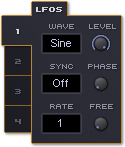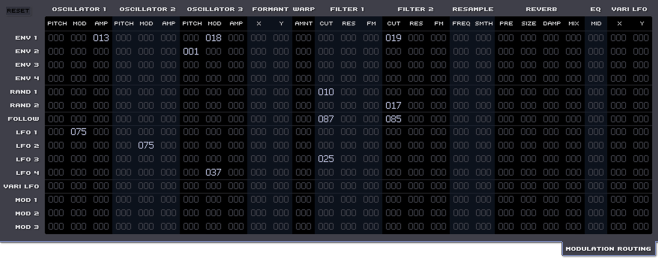Modulation
Blarg features extensive modulation options which allow the majority of synthesis parameters to be modifed automatically.
Of the various modulation sources Envelope 4 is a special case, in that it is "hard-wired" to the oscillators' output volume. Therefore if Envelope 4 is completely flat there will be no sound.
LFOs

Four low frequency oscillators.
| WAVE | A choice of 22 LFO waveforms, illustrated below. |
| LEVEL | The overall level of the LFO's output. This control is included primary for automation purposes, for example controlling the depth of the LFO via MIDI with a mod wheel controller. |
| SYNC | Selects whether to restart the LFO at the beginning of it's cycle when a key is pressed (KEY), at the start of a bar in the host sequencer (BAR) or to |
| PHASE | Adjusts the position in the LFO's wave cycle to restart the LFO in conjuction with the SYNC parameter. When the RANDOM 2 waveform is selected, the PHASE control acts as a peak follower, with higher values resulting in a smoother waveform. |
| RATE | The frequency of the LFO measured in beats at the host tempo, or controlled directly with the FREE control. |
| FREE | Directly controls the rate of the LFO when the RATE parameter is set to FREE. |
LFO wave shapes:

Vari LFO

A variable low frequency oscillator with two modes of operation, selectable with the MODE control.
In Rate mode, the Vari LFO functions in exactly the same way as the four regular LFOs, except four seperate RATE parameters can be set and the joystick control mixes between them.

In Mix mode the joystick control mixes between the output of the four LFOs.
Envelopes

Four multi-stage graphical envelopes. Click and drag the control points to adjust the time and level of each envelope stage. Hold shift while dragging for more precise adjustments, hold control while dragging for even finer control.
Clicking on an envelope stage cycles through the available curves between two control points. To prevent accidentally changing the curves when adjusting control points on the envelope, click the padlock icon at the bottom right of the envelope display to lock the current envelope shape.
| STAGES | The number of stages which comprise the selected envelope. |
| REPEAT | Selects the stage which the envelope will repeat from when it reaches either the end of the final stage or the end of the stage specified by the SUSTAIN parameter. |
| SUSTAIN | Selects the stage at which the envelopes output will freeze for as long as a note is held if REPEAT is set to Off, or resume from the beginning of the selected repeat stage. |
| TOTAL TIME | The combined duration of all the envelope's stages. Displayed in seconds, or beats at the host tempo if the BEATS button is lit. |
| STAGE TIME | The duration of the currently selected stage in seconds, or beats if the BEATS button is lit. |
| STAGE SHAPE | Selects from 14 different types of curve which governs how the envelope's output varies over time during the currently selected stage: Linear,Exp,Inv Exp,Exp2,Inv Exp2,Root,Inv Root,Exp Root,Inv Exp Root,S Crv,Inv S Crv,S Crv2,Inv S Crv2,Step. |
| V AMP | Velocity - amplitude : Controls how much the overall level of the envelope is modulated by note velocity. |
| V TIME | Velocity - time : Controls how much the overall duration envelope is modulated by note velocity. A higher value for this parameter results in a shorter time. |
| BEATS | Toggles display of the envelope times between seconds or beats (at host tempo). |
Modulators

Three freely assignable controls which act as modulation sources. These are useful for controlling a number of synthesis parameters with a single control, for example adjusting the cutoff frequency of both filters simultaneously or cross-fading between two oscillators, etc.
Modulation Routing
The modulation routing panel is the means by which the various modulation sources are linked to synthesis parameters, It is accessed by clicking the MODULATION ROUTING pulldown at the top-right corner of the main instrument interface display. The layout is a matrix, with 15 available modulation sources down the left side and 27 destinations along the top.
Click and drag a value in the matrix to adjust how much a modulation source modifies a corresponding parameter. Hold shift for more precise adjustment. Double-click a value to reset it to zero. Clicking the RESET button at the top-left of the panel to reset all values to zero.
A modulation value is added to a synthesis parameter as opposed to over-riding it, so for example if an oscillator's MOD control is set to maximum, modulating it by a positive amount will have no effect.
Note that modulating a monphonic paramater (eg. the resampler frequency) with a polyphonic source (eg. an envelope) may produce unpredicatable results unless the instrument is operating in MONO mode.
Modulation sources:
| ENV 1 to 4 | The 4 Envelope outputs. |
| RAND 1 & 2 | A value is selected from a randomly varying signal each time a key is triggered and remains constant for the duration the key is held. |
| FOLLOW | Key follow : corresponds to the pitch of the currently playing note. This is commonly used to modulate a filter's cutoff frequency so the filter cutoff increases when higher notes are played. |
| LFO 1 to 4 | The 4 LFO outputs. |
| VARI LFO | The variable LFO output. |
| MOD 1 to 3 | The three modulator controls. |
Modulation destinations:
| OSCILLATOR : PITCH, MOD, AMP | The pitch, modify and amplitude paramaters of the oscillators. |
| FORMANT : X, Y | Added to the X and Y position of the formant modifiers joystick control. |
| WARP : AMNT | Warp modifier amount. |
| FILTER : CUT, RES, FM | Filter cutoff, resonance and frequency modulation parameters. |
| RESAMPLE : FREQ, SMTH | The resampler effect's sampling frequency and output smoothing. |
| REVERB : PRE, SIZE, DAMP, MIX | The reverb effect's pre-delay, room size, damping and wet/dry balance parameters. |
| EQ : MID | The frequency of the EQ effect's mid band. |
| VARI LFO : X, Y | Added to the X and Y position of the variable LFO's joystick control. |
